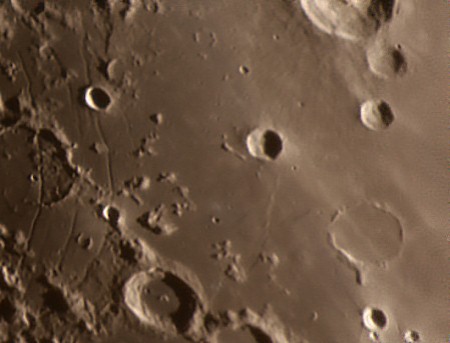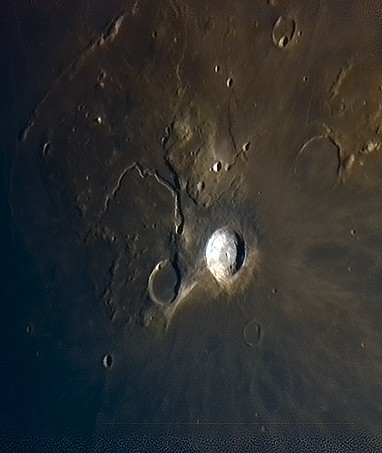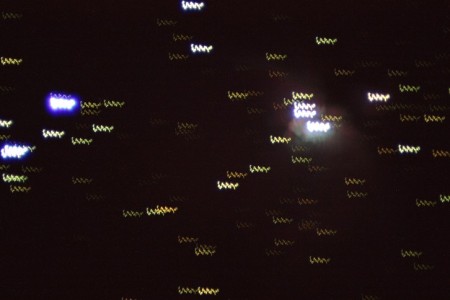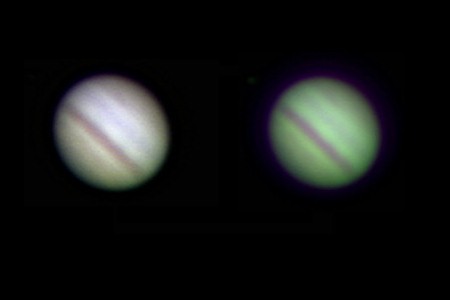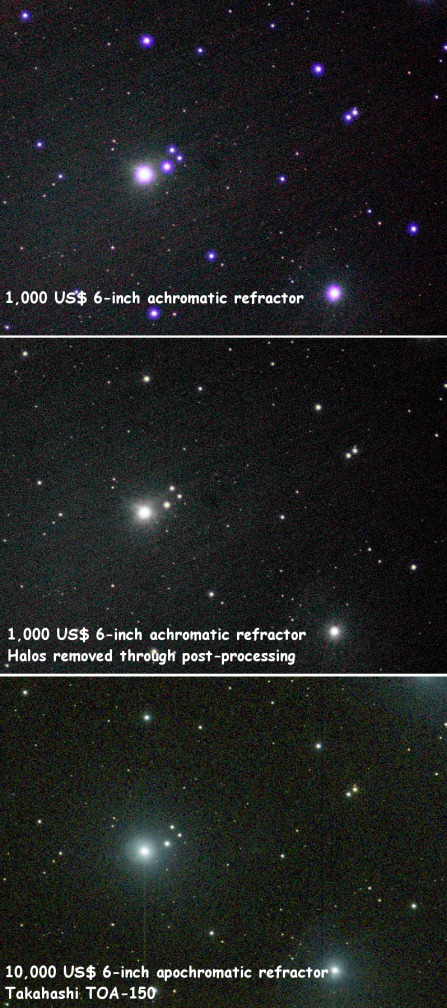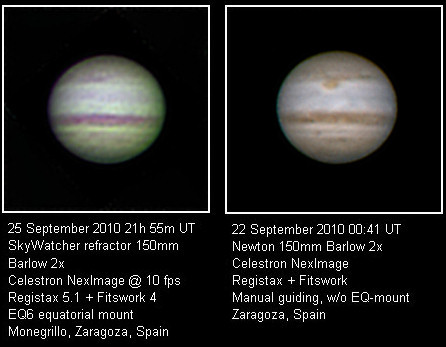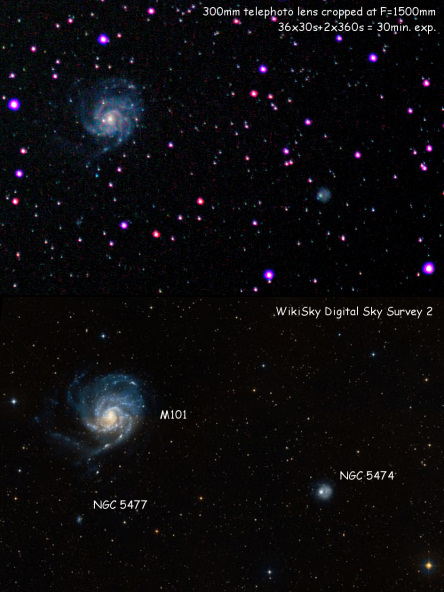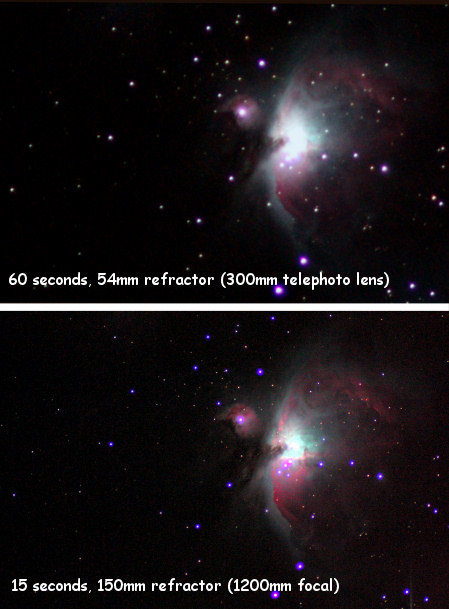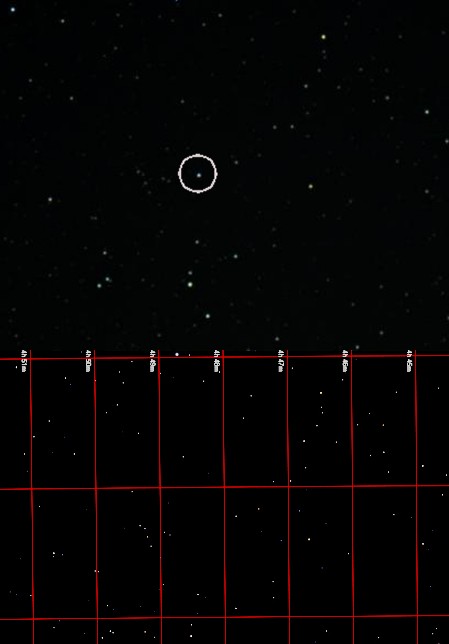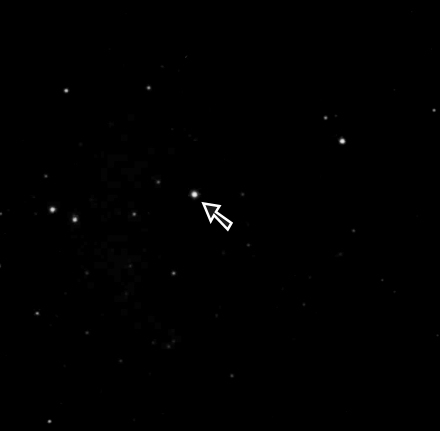Very close to Tringulum galaxy M33 we may spot a bright open cluster towards Perseus constellation. Its name is M34 and here it is a picture I took today through a remote 6 inch apochromatic refractor on New Mexico that shows colorful stars. Enjoy it!
M34 Open Cluster at Perseus Constellation
Posted in Astrophotography with tags 6 inches, apochromatic, Astronomy, Astrophotography, color, Fitswork4, M34, Open Cluster, Paint Shop Pro 9, refractor, starts, Telescope on 2013/10/12 by computerphysicslabJupiter through a 10 inch Mewlon telescope
Posted in Astrophotography with tags 10 inches, Jupiter, Mewlon, observation, takahashi, Telescope, visual on 2013/02/09 by computerphysicslabThe telescope is a reflector Takahashi Dall-Kirkham at f/12, yielding 3 meters of focal.
I have also realized that when sit down in a chair and keeping the vision of the planet during several minutes trying different focus, the eye eventually adapts to the brightness of the planet and increasingly captures more details.
Here it is a picture of the setup:
Vallis Alpes on the Moon
Posted in Astrophotography with tags Cassini, Frigoris, Maria, Moon, Plato, Vallis Alpes on 2012/10/02 by computerphysicslabBuy now a telescope to see the stars
Posted in Astrophotography with tags Astronomy, Buy, Stars, Store, Telescope on 2012/08/20 by computerphysicslabCheck out our new telescope store. Cheap prices and fast deliveries.
Milky Way Time Lapse with Canon EOS 450d
Posted in Astrophotography with tags Canon EOS 450D, Milky Way, Rebel XSi, Time-Lapse on 2012/06/18 by computerphysicslabMilky Way rises by the East. Sagittarius on the left and Scorpius on the right.
Supernova at M95
Posted in Astrophotography on 2012/03/25 by computerphysicslabAt coordinates R.A. = 10h 43m 53s, Decl. = +11º 40′ 17″ and magnitude around 13 yesterday I could spot and record with DSLR camera the M95 supernova. This picture was taken through a 300mm telephoto lens on an EQ6 equatorial mount w/o autoguider.
The field was illuminated by a near bright planet, Mars, that became quite useful to locate the event in the sky.
Moon scratched by the claw of a bear
Posted in Astrophotography with tags Astronomy, Astrophotography, Bullialdus crater, Canon EOS 450D, Manual-Crazy-Tracking, Meade Lightbridge 16", Moon, Newtonian, no tracking, Reflex, Registax, Rimae Hippalus, Telescope on 2011/08/31 by computerphysicslabNear Bullialdus crater (at top-right side of the picture) there is a quite interesting region called Rimae Hippalus. Hippalus crater is the big one (left-center side of the picture). It is a big crater. In this image, shadows in this crater due to a low altitude sunlight creates a visual effect, as if a great creature had stamped his bare footprint in lunar soil. Do you see it?
Saturn through amateur telescope
Posted in Astrophotography on 2011/07/10 by computerphysicslabIn reply to your video “White storm on Saturn through amateur telescope near 2011 opposition”
Hi!
I’m really impressed by your video here. I want to do the same this weekend and was a little bit disappointed on how poor DSLRs are for planets compared to webcams, or cams like DMK41 etc. But your video shows me that it’s possible to take good pictures/videos 🙂
I have a few quick questions please 🙂 – you’ve done this on a altazimuth mount? like the 8 inch Newton (Dobson) I have?
What were the settings for the video? I have a Canon EOS 600D – which would be better – more resolution (full hd) but less fps or lower resolution and more fps? I hope that it’s not a problem that my cam records mov files instead of avi files.
did you use eyepice projection or a barlow? and how long was your source video for registax? sooo many questions 🙂
But when I see some images in Internet I always hope that the 600D was not a mistake to buy.
Thanks in advance :-), Best regards, Michael
——-
Hi Michael,
A DSLR camera can also take good high quality videos like a DMK camera, at least in the case of my Canon EOS 450d using a free software called eos_movrec you will find in Internet. This software makes AVI files.
I guess Canon EOS 600d also lets you apply this technique.
This video Saturn video was recorded using a robotic altazimuth mount, that comes with Celestron C5 Nextstar telescope.
Sometimes I use a barlow, and other times eyepiece projection if barlow is not enough. Barlow is good for lunar pictures but not eyepiece projection, only useful at planets, due to its wild field curvature, spoiling the borders of the image.
Bright nebulae at Milky Way core
Posted in Astrophotography with tags Astronomy, Astrophotography, Canon EOS 450D, constellation, Deep sky, Fitswork4, Milky Way, nebula, Rebel XSi, Reflex, Sagittarius, Scorpius, Telescope on 2011/07/04 by computerphysicslabSummer views of Milky Way are spectacular because the galaxy bulge is brighter and broader than its spiral arms visible the rest of the year. Located near Sagittarius and Scorpius constellations, the bright nebulae and dark lanes of the area creates a beautiful contrast in brightness and colors.
This picture is a 4-pane mosaic ensambled with free software Fitswork 4.40. Every pane is a 10 minutes exposition through a 55mm lens attached to a Canon EOS 450d (Rebel XSi) DSLR camera, mounted over a motorized equatorial mount, Sky Watcher EQ6.
A full resolution picture is available at AweSky
Aristarchus crater (Moon) with Meade Lightbridge 16 inch
Posted in Astrophotography with tags Astronomy, Astrophotography, Canon EOS 450D, crater, Manual-Crazy-Tracking, Meade Lightbridge 16", Moon, Newtonian on 2011/04/17 by computerphysicslabAristarchus crater (Moon) with Meade Lightbridge 16 inch:
Aristarchus is a large impact crater on the Moon, is in the northwest of the nearside of the Moon. It is considered the brightest of the large formations on the lunar surface, its albedo is nearly double that of most other geographical spots. The crater is bright enough to be visible to the naked eye and is stunning when viewed through a large telescope. It is also easy to identify when most of the lunar surface is illuminated by reflection of light on Earth.
The crater is located on the southeast edge of the Aristarchus Plateau, an area that contains several high volcanic features, such as wrinkling rimes. This area is known for it have been detected in a significant number of transient lunar phenomena of nature as well as by recent emissions gas radon to be measured by the spacecraft Lunar Prospector.
EQ6 periodic error
Posted in Astrophotography with tags Astronomy, Astrophotography, Canon EOS 450D, Deep sky, DSLR, EQ6, guiding, mount, PEC, periodic error, Rebel XSi, Reflex, Sky Watcher, tracking on 2011/04/06 by computerphysicslabI took a bunch of 30 seconds shots aiming M42 nebula as regular, in order to stack them later. Polar alignment was also regular, using EQ6 polar scope, probably not perfect.
I think M42 is a good target to measure periodic error in RA movement due to its near 0 degrees declination.
In order to show the drift, I stacked the shots without drift correction using a free software called startrails that gets the brightest pixels per shot, obtaining that way the best startrail you can achieve.
To measure the length of the drift, I requested a single shot solved plate from astrometry.net. They provide an exact width in arcminutes of the field. Then, I divide the width field by the width in pixels of my DSLR camera sensor, obtaining the resolution per pixel in arcseconds (a number close to 1 arcsecond/pixel for a 1,200 mm effective focal length telescope).
Then I measure the height of RA drift pattern with my regular post-processing free software, Fitswork4, and multiply that value by the previous resolution.
That is the way I have found that my EQ6 mount drifts around 40 arcseconds in RA movement. Dividing total exposure by the number of cycles (top peak to lower peak) I got the elapsed time needed to fulfill the periodic error: around 6 minutes long.
Moons of Saturn through telescope
Posted in Astrophotography with tags Astronomy, Astrophotography, Camera, CCD, Celestron, DBK, Dione, Iapetus, Moons of Saturn, planet, planetary, Registax, Rhea, ring, satellites, Saturn, shift-and-add, solar system, stacking, Tethys on 2011/03/09 by computerphysicslabTitan, Tethys, Rhea, Dione, Iapetus are five bright moons of Saturn, the ring planet in our Solar system. They can be observed through amateur telescopes with at least 100mm (4 inches) of aperture. The following picture was taken through a 5 inch telescope, a Celestron NexStar 5 SE XLT. It is an image composed of 84 single subframes of 1 second of exposition each one.
It was taken on 2011-03-06 02h10mUT using a DBK 21AU04.AS Imaging Source CCD camera. Planet was recorded in a different exposition through a video stacked (shift and add) using Registax free software.
Check out the JPL simulation matching the picture above.
Mare Crisium and Palus Somni
Posted in Astrophotography with tags Astronomy, Astrophotography, Canon EOS 450D, craterlets, craters, Impact crater, Mare Crisium, Moon, Palus Somni, Proclus, Rebel XSi, solar system, Telescope on 2011/02/28 by computerphysicslabMare Crisium is one of my favorite Moon areas. There is a lot of details inside Crisium, but it is not easy to detect, because it is very fine. High aperture telescopes are needed to spot the small impact craters inside this maria, because its typical lengths are 1 or 2 kilometers wide.
Near Mare Crisium there is another big area called Palus Somni (below), that is visible in this picture made with an amateur telescope. The big and bright crater in the middle is Proclus:
The telescope used is a Celestron Nexstar 5SE and the camera is a Canon EOS 450d (Rebel XSi) DSLR. The picture actually is a mosaic made of two panes.
Celestron NexStar 5SE vs Takahashi FS102
Posted in Astrophotography with tags Amateur, Apochromat, Astronomy, c5, Catadioptric, Celestron NexStar 5SE, Fitswork4, fluorite, planet, refractor, Registax, Saturn, Schmidt-Cassegrain, Takahashi FS102, Telescope on 2011/02/19 by computerphysicslabThis week I had the chance to test a Takahashi FS102 refractor apochromatic fluorite telescope and also a Celestron NexStar 5SE Schmidt-Cassegrain catadioptric telescope. First one has an aperture of 102mm and second one of 125mm plus a central obstruction. Their light gathering power is similar and also their theoretical resolution. Nevertheless I wanted to check by myself the mythical optical quality of FS102 in contrast to the well-known Celestron.
Tests were made using the same camera to capture video and similar weather conditions both nights. I took in both cases a video of the planet Saturn when reaching the meridian, its maximum altitude. Celestron C5 perform flawlessly because I could get a sharp view of Saturn and its ring at 500x magnification. Takahashi also let me reach that high powers with a crisp result. C5’s focuser is very precise, but Takahashi’s is even more being a rack and pinion system. Focusing the FS 102 was very pleasant due to its smoothness and accuracy. Probably a better contrast in visual images delivered by refractor telescopes also gave it an advantage here.
Trying to resolve fine details, in both telescopes I could see the shadow of Saturn over the rings clearly. Here it is the final picture after applying Registax and Fitswork4 to both videos.
Sharing raw footage of Jupiter and Saturn
Posted in Astrophotography with tags apochromatic, Astronomy, Canon EOS 450D, fs102, Jupiter, Rebel XSi, refractor, Registax, Saturno, stacking, takahashi, Telescope on 2011/02/11 by computerphysicslabOn 2011-02-06 I took some videos of Jupiter and Saturn through a (4 inch) 102mm apochromatic refractor telescope. Applying Registax I got the results of the picture.
I’d like to share these two videos with anybody interested in playing with them:
http://www.mediafire.com/file/tqkri1z5z4pw8ge/Saturn-Takahashi-FS-102-F40-2011-02-06-divx.avi
http://www.mediafire.com/file/jbu38q5ucq9diwz/Jupiter-Takahashi-FS-102-F40-2011-02-06-divx.avi
Fringe color filter – Achromatic refractor
Posted in Astrophotography with tags Astronomy, Astrophotography, filter, Jupiter, Refracting telescope, Telescope on 2010/12/12 by computerphysicslab
- Image via Wikipedia
Fringe color filters are able to cut almost completely the secondary spectrum on images taken through telescopes that yield chromatic aberrations, like an achromatic refractor. Here is an example of the difference between an picture of Jupiter taken through a fringe color filter (left) and a similar picture taken without that filter (right).
Related articles
- Tips on Learning to Use Telescopes (brighthub.com)
- Good Telescopes for Kids (brighthub.com)
North America Nebula
Posted in Astrophotography with tags Astronomy, Astrophotography, Canon EF-S 18-55mm, Canon EOS 450D, Cygnus, Deep sky, Fitswork4, Milky Way, NGC 7000, North America Nebula, Paint Shop Pro on 2010/11/04 by computerphysicslabThis picture of North America Nebula (NGC 7000, a bright nebular region located in the Milky Way area of Cynus) was taken yesterday, 2010-11-03 under good transparency skies, using a 55mm lens and Canon EOS 450d, Rebel XSi and an EQ6 mount doing the unguided tracking. This is just one shot of 1380 seconds of exposition (23 minutes).
Postprocessing done using PSP9 and Fitswork4.
NGC 7000 is an emission nebula in the constellation Cygnus, near Deneb (α Cygni), also called the North American Nebula. The dark central region called the Gulf of Mexico, as in some astronomical plates for many years resembled that region of America.
Nebula NGC 7000 is the largest covering an area equivalent to the full moon, but its low surface brightness does not normally visible to the naked eye (though, in a dark, using a UHC filter can be seen without optical aid) NGC 7000 and the nearby Pelican Nebula (IC 5070) are part of the same interstellar cloud of ionized hydrogen (HII region). The dark area in the center is a very dense region of interstellar material in front of the nebula and which absorbs light of it, giving the group its characteristic shape.
It is not known with precision the distance that separates us from NGC 7000, neither the star responsible for the ionization of hydrogen that results in the emission of light. Supposing Deneb is the star that illuminates the nebula NGC 7000 then the distance to Earth is on the order of 1800 light years.
Pluto, a dwarf planet
Posted in Astrophotography with tags 6-inch, Astronomy, dwarf, planet, pluto, refractor, solar system, Telescope on 2010/10/22 by computerphysicslabThis picture is the result of stacking 9 subframes of 120 seconds of exposition each one through a 6-inch refractor telescope.
Pluto is a dwarf planet in the solar system, part of a double planetary system with its satellite Charon. It has a highly eccentric orbit inclined to the ecliptic, which runs until closer at perihelion inside the orbit of Neptune. The Pluto-Charon system has two moons: Nix and Hydra. These are celestial bodies that share the same category.
It was discovered on February 18, 1930 by American astronomer Clyde William Tombaugh (1906-1997) from the Lowell Observatory in Flagstaff, Arizona, and as the ninth and smallest planet in the Solar System by the International Astronomical Union and public opinion from then until 2006, but their group of planets in the solar system was always the subject of controversy among astronomers.
Its great distance from the Sun and the Earth, coupled with its small size, prevents shine below the magnitude 13.8 in its best moments (orbital perihelion and opposition), so it can be spotted only with telescopes bigger than 200 mm aperture (although there are people that says it can be spotted through apertures of 125 mm), photographically or CCD camera. It appears as star-looking, yellow, featureless point of light (apparent diameter of less than 0.1 arcsec).
Apochromatic vs Achromatic Refractor
Posted in Astrophotography with tags aberration, achromatic, apochromatic, Astronomy, Astrophotography, chromatic, compare, equipment, myth, Sky Watcher, takahashi, Telescope, versus on 2010/10/14 by computerphysicslabPeople should think twice before purchasing an apochromatic refractor as opposed to an achromatic telescope. There is a huge difference in price and a small difference in performance according to an experiment I made recently.
In doing astrophotography, people use to spend a lot of money in equipment. It is important not to fall into the elitist apochromatic myth if you want to save some money.
I took a single 30 seconds shot to Pleiades open cluster (M45) using my 6-inch Sky-Watcher achromatic refractor that costs around 1,000 US$. Then I used a 6-inch apochromatic Takahashi TOA-150 that costs around 10,000 US$ to take an equivalent shot on the same field.
Resulting images speak by themselves. Obviously achromatic refractor shows a blue halo around stars, due to chromatic aberration. Nevertheless, a simple post-processing technique can remove the halo, obtaining a similar image to apochromatic’s.
Now, the question is: Is it worth paying the extra 9,000 US$?
Comet 103P/Hartley
Posted in Astrophotography with tags 103P, Astronomy, Astrophotography, Comet, Hartley, Hertley2, Telescope on 2010/10/12 by computerphysicslabComet Hartley 2, officially known as 103P/Hartley 2 is a small comet that orbits the Sun with a period of 6.46 years. It was discovered by astronomer Malcolm Hartley in 1986 using the Schmidt telescope in Siding Spring Observatory (Australia).
It is estimated that its nucleus has a size between 1200 and 1600 meters, according to recent observations of the Spitzer Space Telescope (August 2008): its albedo, very small, is close to 0.028 as it is covered with very dark carbonaceous bodies probably hydrocarbons. The mass is estimated around 3 × 10 ^ 11 kg.
In its approach to the Sun of 2010 is visible in the constellations of Cassiopeia, Perseus and Auriga, but could be visible to the naked eye in mid-October of that year from places with dark skies: it reaches its minimum distance from our planet on October 20th standing at only 0.12 Astronomical Units. A few days later, on October 28th, passes through the perihelion located a little over 157 million miles from our star.
In their approach the year 2010 this image was obtained through a 6-inch refractor telescope.
Its next step takes place on April 2017.
Jupiter 2010 Opposition
Posted in Astrophotography with tags 2010, Astronomy, Astrophotography, Jupiter, Opposition, Telescope on 2010/10/03 by computerphysicslabCurrently, Jupiter is at its minimum distance from Earth, which does not happen since 47 years. While the largest planet in the solar system can always be spotted with the naked eye, this time will look brighter.
The phenomenon is called opposition, and occurs when a planet is located exactly opposite to the Sun in the sky, meaning, the same side of Earth’s orbit about the sun. In such cases, the distance between the two planets is minimal. The oppositions between Earth and Jupiter occur every 13 months.
However, as the orbits of both planets are not perfectly round nor perfectly concentric, these approaches are not always the same. There is a “better” and a “worse” opposition. And the gap between the two planets varies from 591 to 676 millions of kilometers. Consequently, the brightness and apparent size of Jupiter also varies.
The current opposition of Jupiter is excellent, with the planet at nearly 592 million of kilometers from Earth. Equivalent to about 1,500 times the distance to the Moon, but Earth and Jupiter can not get much closer than that. The last time Jupiter was so close to Earth in October 1963 was 47 years ago. And it will not happen again until September 2022.
Capella, the brightest star in Auriga
Posted in Astrophotography with tags Astronomy, Bright star, Canon EOS 450D, Deep sky, DeepSkyStacker, EQ6 equatorial mount, Rebel XSi, Reflex, Tamron SP-54B 300mm on 2010/10/02 by computerphysicslabCapella is the brightest star in Auriga constellation. It is very easy to spot in the Northern hemisphere. It is a circumpolar star, very bright one. The picture has been taken through a 300mm telephoto lens and Canon EOS 450d over a Sky Watcher EQ6 equatorial mount.

Here it is the full frame, with a lot of stars in the field and great detail:
http://www.awesky.com/Deep+Sky/Misc/Capella+-+Alpha+Aurigae/
My Jupiters at ALPO
Posted in Astrophotography with tags ALPO, image, Jupiter, picture, planet, Registax on 2010/09/28 by computerphysicslabALPO has a webpage where people around the world uses to post their best planetary images. Recently I got two pictures of picture through a Newtonian and through a refractor telescope. ALPO webpage published my pictures at these URLs:
http://alpo-j.asahikawa-med.ac.jp/kk10/j100925z.htm
http://alpo-j.asahikawa-med.ac.jp/kk10/j100922z.htm
And these are the images:
M57, the Ring Nebula
Posted in Astrophotography with tags afocal, Astronomy, Canon EOS 450D, Deep sky, M57, Messier 57, NGC 6720, Planetary Nebula M57, Rebel XSi, Reflex, Ring Nebula, Telescope on 2010/09/21 by computerphysicslabThe Ring Nebula (also known as the Planetary Nebula M57, Messier 57, M57 or NGC 6720) is a prototypical planetary nebula in the constellation of Lyra. This is one of the most famous nebulae often used as an example of this type of astronomical objects. It is located at 0.7 kpc (2300 light years) from Earth and was discovered by Antoine Darquier de Pellepoix in 1779.
Their joint magnitude V-band (green filter) is equal to 8.80. Its real form is possibly a bipolar nebula seen with an inclination of 30 ° from its axis, and calculated that it has been expanding around 1600 years.
From their radial velocity, -19.2 km/s, it follows that approaches Earth more than 69120 km/h: this rate is caused by the combination of the sun’s orbital speed around the nucleus of the Milky Way and the speed of the Earth itself.
M57 is illuminated by a white dwarf at its center of visual magnitude 15.8.
This picture is a single shot of 30 seconds exposition through a SkyWatcher 6 inches refractor telescope at prime focus. Fitsworks4 was used to remove a bit the background noise.
M101 with 300mm telephoto lens
Posted in Astrophotography with tags Astronomy, Canon EOS 450D, Deep sky, DeepSkyStacker, EQ6 equatorial mount, M101, NGC 5474, NGC 5477, Rebel XTi, Reflex, Tamron 300mm, Ursa Major on 2010/04/25 by computerphysicslabThis is a crop of the resulting stacking of 36x30s + 2x360s subframes taken this month in two different sessions. The area showed corresponds to M101 and surroundings (in Ursa Major), in which we find other 2 galaxies NGC 5474 and NGC 5477. Below, I have added a DSS2 image of the are for comparison. My stars are blobs, meanwhile DSS2 are pinpoint. On the other hand, I use to lose star colours specially in the brightest ones , when postprocessing and stretching histogram. Maybe some day I will learn how to fix all these errors …
Saturn with a 6 inches refractor
Posted in Astrophotography with tags 150 mm, 6 inches refractor, achromatic, Astronomy, Casio Exilim EX-FS10, Fringe Killer, psp9, Registax, Saturn, Sky Watcher, Telescope on 2010/04/10 by computerphysicslabM31 – Andromeda Galaxy
Posted in Astrophotography with tags Andromeda, Astronomy, Canon EOS 450D, DeepSkyStacker, Galaxy, M31, m32, NGC 110, psp9, Rebel XTi, Reflex, Tamron 300mm telephoto on 2010/04/08 by computerphysicslabI took last winter 92 shots of 30 seconds to M31 using my 300mm telephoto lens. An EQ6 equatorial mount holded the Canon EOS 450d (Rebel XTi) camera. After stacking them with DeepSkyStacker and some post-processing with PSP9, here it is the result. The imaga shows M32 and NGC 110 too. I hope you enjoy it:
A 300mm telephoto vs a 6 inches refractor
Posted in Astrophotography with tags 6 inches refractor, Astronomy, Canon EOS 450D, EQ6 equatorial mount, M42, Rebel XTi, Reflex, Tamron SP-54B 300mm, Telescope on 2010/02/22 by computerphysicslabThe Tamron SP 54 is a 300mm telephoto lens, with an aperture of 54mm. I took a 60 seconds of exposition image of M42 in Orion. A few months later I took a 15 seconds image of the same field through a 6 inches Sky-Watcher non-apo refractor.
The comparison throws some interesting conclusions:
1.- A 150mm lens gives more resolution than a 54mm lens. Stars are fainter in the 6 inches refractor picture.
2.- The light captured by a 54mm lens in 60 seconds is nearly equivalent to the one captured by a 150mm lens in 15 seconds. Nebulosity appears practically equal in brightness in the two pictures. The lower image is a full frame, meanwhile the upper one is cropped at 25%.
Both images were taken using an unmodded Canon DSLR camera, EOS 450D (or Rebel XTi) and an EQ6 equatorial mount.
Demo game
Posted in Games with tags 2d, exe, game, pc, windows on 2010/01/03 by computerphysicslab Download computerphysicslab-demo-game.jpg and rename it to a .exe file. Then execute and send me a comment with your opinion. Thanks
Download computerphysicslab-demo-game.jpg and rename it to a .exe file. Then execute and send me a comment with your opinion. Thanks
Nova in Eridanus
Posted in Astrophotography with tags 2009, Bradford, C14, Canary Islands, Eridanus, Nova, robotic, Teide, Telescope on 2009/12/20 by computerphysicslabIn spite of the cloudy skies I could get a shot of a Nova that has appeared in Eridanus constellation. The key to get this shot is having used a remote robotic telescope through Internet, Bradford telescope located at Teide mountain in Canary Islands.
The image is the result of 2 minutes of exposition through the Cluster camera of Bradford Robotic telescope. The Nova is located at 6 degrees from Rigel (Orion). There is attached a map of the area, in which it is visible that the Nova is not registered in the chart.
And here it is the same area as viewed with more magnification through the Celestron C14 main telescope at Bradford Observatory. The image was taken on 2009-12-25, so several days after the previous image, but Eridanus Nova remains clearly visible.
M31 from above
Posted in Astrophotography with tags Andromeda, Canon EOS 450D, Galaxy, M31, Perspective, Rebel XTi, Reflex, Tamron SP-54B 300mm, Telephoto on 2009/11/13 by computerphysicslabHere we see Andromeda galaxy as viewed from above. The spiral arms and structure becomes visible clearly in this processed image with a distortion nearly equivalent to a change of the observer location from our galaxy to a point in the void intergalactic space just above M31.
The original image from which this perspective has been obtained was a 4 minutes exposure with a 300mm telephoto lens and a DSLR Canon EOS 450d (Rebel XTi) camera.

A very fast Lightbridge 16 review
Posted in Astrophotography with tags Collimation, Meade Lightbridge 16", Newtonian, Telescope on 2009/11/06 by computerphysicslabHello, Id like to ask a question about your experience with the 16″ Lightbridge. I’ve read some good reviews and bad reviews about it. I’ve read that it is very hard to collimate and that the focuser may not come perfectly perpendicular to the tube assembly from the factory and may need shimming to properly align it.
I’d like to know your opinion on these things and also the quality of the focuser. Is there much flex in the trusses? Have you been able to attain crisp clear focus? Would you recommend this scope, or to rather spend an extra $1000 to get a similar sized Discovery scope?
Thanks!
-Joey
————————————————–
Collimation is an important issue when observing through Meade Lightbridge 16″. Mainly for planets and Moon, because a good collimation gives much better images at high magnification. When moving the telescope, it is usual to get discollimation, so every time you move it, you firstly have to collimate it before observing.
Another disadvantage of this telescope is its weight. It weights a lot and it is not easy to move from one place to another.
Nevertheless starfield views are incredible due to its high aperture, mainly under dark skies. It becomes very easy to observe deep sky objects. It is impressive to observe Dumbell nebula at 200x.
To attain crisp clear focus is very difficult when observing planets or the Moon due to atmospheric turbulence. 16 inches of aperture are very sensitive to turbulence.
I would recommend the telescope if you are planing to be observing always at the same place. It is a very cheap telescope taking into account its aperture.
I cannot talk about Discovery telescope, because I have never watched through one of them.
Regards,

Polaris A & Polaris B
Posted in Astrophotography with tags afocal, Astronomy, Canon EOS 450D, Deep sky, Newtonian, no tracking, Polaris, Polaris A, Polaris B, Rebel XTi, Reflex on 2009/10/18 by computerphysicslabPolaris has a close neighbor at 18 arcseconds that can be spotted easily through a telescope.

This is a 15 seconds exposure through a Meade Lightbridge 16-inch, a Dobson with no tracking, but fortunately Polaris moves very slowly through its small circumpolar path, due to its proximity to north pole in the sky. The camera used was a Canon EOS 450d, also known as Rebel XTi. The method employed was an eyepiece projection using a 14mm Meade Series 5000.
Auriga and Moonlight
Posted in Astrophotography with tags Astronomy, Auriga, Canon EOS 450D, constellation, Moon, no tracking, Rebel XTi, Reflex, shift-and-add on 2009/10/10 by computerphysicslabThis is a set of 71 single shots of 10 seconds each one to the Auriga constellation on 2009-10-08. The Moon was located at its south and its brightness is visible on the edge of the image and on the background gradient. The single frames were recorded using a Canon Rebel XTi (EOS 450d) and a conventional EF 18mm lens. The Kids is a triangle of stars on the upper side of Auriga constellation.

Tamron EOS Adaptor
Posted in Astrophotography with tags Adaptor, Astronomy, Canon EOS 450D, Pixco, Rebel XTi, Reflex, Tamron SP-54B 300mm on 2009/10/09 by computerphysicslabIn order to attach Tamron SP 54B 300mm telephoto lens to DSLR camera Canon EOS 450d (Rebel XTi) I used an adaptor found at ebay (Looking for “Tamron Adaptall 2 Lens To Canon EOS EF Mount Adaptor”). It works properly and it is very accurate when focusing to infinite. Pixco is the brand adaptor.

Tamron 300mm lens on Canon EOS
Posted in Astrophotography with tags Astronomy, Canon EF-S 18-55mm, Canon EOS 450D, Rebel XTi, Reflex, Tamron SP-54B 300mm on 2009/10/08 by computerphysicslabTamron SP-54B 300mm is a telephoto lens built 30 years ago, oriented to analog reflex camera market. Thanks to a special adapter for Canon EOS DSLR camera, I could attach them each other and take some shots. The field of view and the magnification are very different to a conventional lens, like Canon EF-S 18-55mm.
Here it is a comparison image:

Reaching Binocular focus
Posted in Astrophotography with tags afocal, Astronomy, Binocular, blur, Moon, no tracking, sharp on 2009/09/29 by computerphysicslabSomeone asked me for help recently using this comment:
“Hello, I have 16×50 binoculars and a 7.1 mega pixel camera with 4x zoom and I’ve done what you said and looked at the Moon and the images are no where near as close as yours. The image blurs once the picture is taken of the moon and doesn’t seem no where near as close to the moon as yours. Please help.”
I would like to share the answer just in case someone is also interested.
Answer:
16x and 4x should mean a final 64x optical zoom. That is as much as when seeing through a telescope. If you are capturing frames at 7 MegaPixels this is to say they are around 3,000×2,500 pixels in size. When creating a video you need a final image size of 1,000×700 as much, so if you crop a frame of 3,000×2,500 into a final frame of 1,000×700, it would be equivalent to apply a 3x additional zoom to the image, because (1,000×700) * 3 is more o less equal to 3,000×2,500.
Bottom line: do a crop to your 7 Mpx image and you will get an effective 182x magnification.
Respecting the blur, don’t panic. The blur may be a product of the weather conditions, or a thermal issue in your binoculars.
Try to avoid make photos of the Moon when it is located directly over the roof of a neighbour. This is a very frequent source of blurring problems.
Try also to cool down your binoculars before the observation, trying to get a thermal equilibrium with the outdoor temperature.
Be sure that your digicam is functioning with a infinite focus mode. The focus must be achieved manually using the binocular focuser.
If you have the option of taking continuous shots, use it. The majority of the images recorded may be blurred, but sometimes you may get one more clear and sharp.
Well. I hope this helps you to get sharper images.
Good luck.
3Dfication
Posted in Astrophotography with tags 3Dfication, Niels Noordhoek on 2009/09/15 by computerphysicslab3Dfication is a simple and powerful idea. Its author, Niels Noordhoek has developed a nice software that converts the image of a planet (or the Moon) into a rotating sphere creating a kind of flyby illusion. You may download it from his webpage here: http://www.njnoordhoek.com/?p=485
At least in my laptop, several codecs are available to use for the video output. Here it is an example of what results can achieve this software:
Mare Tranquillitatis in color
Posted in Astrophotography with tags 150/750, afocal, Astronomy, Canon EOS 450D, Manual-Crazy-Tracking, Mare Serenitatis, Mare Tranquillitatis, Moon, Newtonian, Paint Shop Pro, Rebel XTi, Reflector, Registax, Telescope, terminator on 2009/09/11 by computerphysicslabColor contrasts in the Moon are interesting even beautiful. The following picture shows Mare Tranquillitatis area and the southern part of Mare Serenitatis in full color. It was taken 4 days after full moon. The shadows in the terminator show the orography of the landscape. Mare Tranquillitatis seems to be mainly blue. This is due to its peculiar chemical composition.
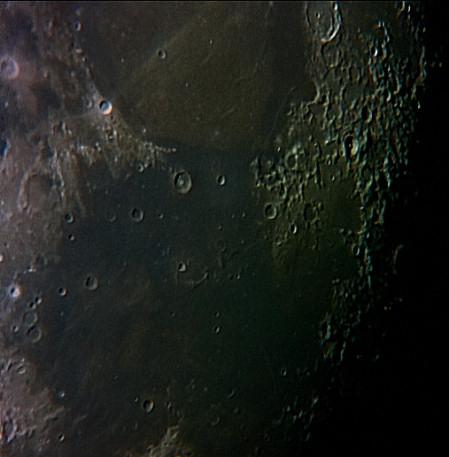
Pitiscus
Posted in Astrophotography with tags 150/750, afocal, Astronomy, Canon EOS 450D, crater, Hommel, Ideler, Manual-Crazy-Tracking, Moon, Newtonian, Noiseware, Paint Shop Pro, Pitiscus, Rebel XTi, Reflector, Reflex, Registax, Spallanzani, Telescope, terminator on 2009/09/09 by computerphysicslabPitiscus, Hommel, Ideler and Spallanzani are the only four craters of the picture with proper name. The rest of them are named by letter surnames like Ideler R or Ideler L. They are located in the South-East area of the Moon. The picture was taken on 2009-09-09 05h 20m U.T. and the terminator was passing across Pitiscus, Hommel, the two big and shadowed craters. Pitiscus is 85 km wide and Hommel is 129 km (76 miles). The smallest craters of the image are 7 km wide, that is 3.5 arcseconds, 1.75 arcseconds for the bright spot and 1.75 arcseconds for the shadow spot. Image detail could then be better for a 6-inch telescope (this is the equipment used to take the image, an scope capable up to 0.7 arcseconds of resolution). 622 subframes were recorded with the Manual-Crazy-Tracking system and stacked in Registax 5.

Posidonius
Posted in Astrophotography with tags 150/750, afocal, Astronomy, Canon EOS 450D, Chacornac, crater, Manual-Crazy-Tracking, Mare Serenitatis, Moon, Newtonian, Noiseware, Posidonius, Rebel XTi, Telescope on 2009/09/08 by computerphysicslabPosidonius is a big crater of the Moon on Mare Serenitatis. There is a lot of interesting details to observe inside: peaks, ridges, craterlets, … In the following image taken yesterday night, 4 km wide craters can be spot as small white points in the smooth surface of Mare Serenitatis.
Posidonius measures 95 km in diameter. The second biggest crater (a bit ghostly) in the picture is Chacornac, just below Posidonius. Inside it is visible a small craterlet called Chacornac A (it measures 5 km in diameter).
The third biggest crater of the picture is Daniell (31 km wide) located in the upper middle side. Its shape is not circular, but oval. This is the cause of a strange effect in perspective when comparing it with the craters nearby.
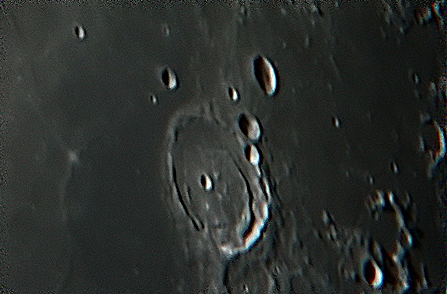
PosidoniusPosidonius is a lunar impact crater that is located on the western edge of Mare Serenitatis
Dorsum Oppel
Posted in Astrophotography with tags 150/750, afocal, Astronomy, Canon EOS 450D, Dorsum Oppel, Manual-Crazy-Tracking, Mare Crisium, Moon, Newtonian, Peirce, Proclus, Swift, Telescope, terminator, wrinkle ridge, Yerkes on 2009/09/07 by computerphysicslabDorsum Oppel is a wrinkle ridge of the Moon in Mare Crisium. 2 days after full moon is the best moment to observe it. It is a very large formation and the landscape along is quite impressive, full of small craters, tiny mountains and the smooth floor of Mare Crisium. It is important to reach a high magnification to enjoy the view (150x at least).
My setup is a 6-inch telescope, but I bet it is possible to observe it comfortably with a 4-inch refractor.

The bright and overexposed crater is Proclus. I have to work harder the dynamic range issue next time.
Swift and Peirce are the pair of craters in the upper side of the picture, near the lunar terminator. Below Peirce should be visible a 2 kms wide craterlet, but unfortunately my picture cannot yield such a resolution. According to a quick calculation, 3 kms is the smallest visible feature in theis image, and that corresponds to 1.5 arcseconds. A bit far still to the maximum theoretical resolution of a 6-inch telescope (that is around 0.7 arcseconds)
Yerkes is the big ghostly crater in the right side. Apparently there is a central peak in its center. I have been looking for a confirmation of the existence of that peak, but I haven’t found any reliable source where it is mentioned. Any hint here, I would be thankful…
Manual Crazy Tracking
Posted in Astrophotography with tags 150/750, afocal, Astronomy, GRS, Jupiter, Manual-Crazy-Tracking, Newtonian, shift-and-add, Telescope, webcam on 2009/09/01 by computerphysicslabLacking of an equatorial mount I have built myself a kind of manual tracking system that keeps into the field of view of a webcam a planet like Jupiter, for 3 minutes. This is long enough to record useful data and then post-process it with aggressive wavelets.
The resulting tracking is not at all perfect. You may see Jupiter swinging around the screen. It is important to capture the data at a fast shutter speed (1/100 sec.) to avoid motion blur in every frame because the planet is always dancing.
In spite of this movement, the results after stacking are very good. Here I show this really simple system and the resulting yesterday’s Jupiter with the webcam:
![]()
![]()
![]()
As you can see the Manual-Crazy-Tracking is a very simple system that consists in a rubber band attached to the tripod handle. If you try to track manually directly pushing the tripod handle, the shaking is excessive and you would need a very very fast shutter speed to get some useful data. The rubber band is necessary to reduce vibrations and increase the shift movement control.
At beginning Jupiter is located in the center of the field of view with no need to any corrections. As long as it drifts due to its sidereal movement you will have to pull using the rubber band in order to keep it in the center of the screen (it is supposed you have a laptop there capturing and showing images from the webcam). This way you may have Jupiter centered in the screen for a long time. You will have time to focus (left hand pulling the rubber band and right hand tweaking the focuser) and time to expose.
Jupiter, Io & Wesley impact scar
Posted in Astrophotography with tags 150/750, afocal, Astronomy, Canon EOS 450D, impact, Jupiter, Newtonian, no tracking, Paint Shop Pro, Registax, scar, shift-and-add, Telescope, Wesley on 2009/08/28 by computerphysicslabGood seeing yesterday too (2009-08-27 23h05m UT). Wesley impact scar is fading day after day, but it is still there. I made an animation that shows Io approaching Jupiter’s limb: http://www.youtube.com/watch?v=78zJtv569y4

Big Jupo
Posted in Astrophotography with tags 150/750, afocal, Astronomy, Canon EOS 450D, EOS Camera Movie Record, Jupiter, Mitchell, Newtonian, no tracking, Paint Shop Pro, Photoshop, Rebel XTi, Reflector, Reflex, resampling, shift-and-add, Telescope, VirtualDub on 2009/08/27 by computerphysicslabI have a good seeing last night. So I got my best Jupiter yet. Here it is:

It is 4x resampled via Registax Mitchell and PS. After resampled I can spot more details in bands and polar zones.
As always I used the 6-inch no-EQ mounted newtonian reflector, the 14mm eyepiece doing afocal projection over the Canon EOS 450d (Rebel XTi) body and recording video using “EOS Camera Movie Record” free software. Three times Jupiter crossed over the field of view. Registax and VirtualDub added and stacked the footage properly.
M42 with point & shoot digicam
Posted in Astrophotography with tags afocal, Astronomy, Binocular, Casio Exilim EX-Z80, digicam, M42, no tracking, Orion, point & shoot, shift-and-add, Vixen 12x80 on 2009/08/26 by computerphysicslabIt is interesting to explore the possibilities of some common devices such as digicams and binoculars. I have been reprocessing some old stuff from March. I took 474 single exposures of M42 in Orion through the binoculars with my Exilim digicam. Using a stacking software, all these subframes may become aligned and added accurately, resulting into a 4 minutes long exposure single shot with a perfect star-tracking. I reckon I didn’t use any kind of equatorial mount or motorized tracking. Just an steady tripod. Orion belt passed accros the field of view of the binoculars 3 times. In every gap, I corrected manually the FOV to get M42 inside it as longest as possible.
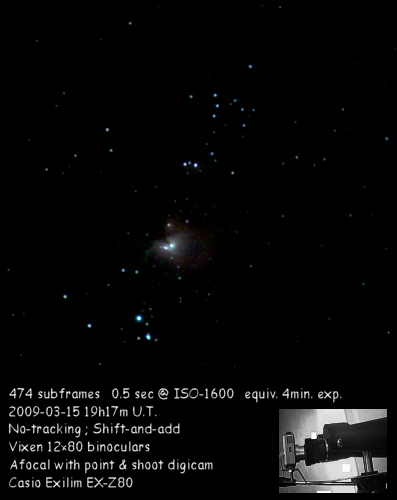
Ganymede’s shadow
Posted in Astrophotography with tags 150/750, afocal, Astronomy, Canon EOS 450D, Europa, Ganymede, Io, Jupiter, moons, Newtonian, no tracking, Paint Shop Pro, Photoshop, planet, Rebel XTi, shadow, shift-and-add on 2009/08/20 by computerphysicslabYesterday night I had the chance to enjoy a multiple moon transition in Jupiter. Ganymede and Europa were crossing Jupiter and throwing their shadows to the big planet. Here it is an image of the event. At 23h 24m U.T Europa’s shadow was not visible yet. Io also appears at the photo but it was beneath the planet. In a minutes it would disappear.
The picture was taken with my digital reflex body (EOS Rebel XTi) and using the video capture software that converts it into a high quality webcam.
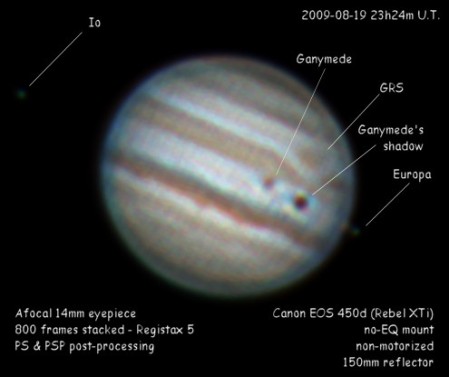
Jupiter Opposition
Posted in Astrophotography with tags 150/750, afocal, Canon EOS 450D, Jupiter, Newtonian, no tracking, Opposition, Paint Shop Pro, Photoshop, Rebel XTi, Reflector, Reflex, shift-and-add, Telescope on 2009/08/17 by computerphysicslab15th August 2009 was the day that Jupiter reached its closest position to Earth. Its apparent diameter was 49 arcseconds, so this is the best time to do planetary astrophotography with the giant planet. Using the afocal technique and a Canon EOS 450d body I took 2 video sequences and processed with Registax 5, Photoshop & Pain Shop Pro.
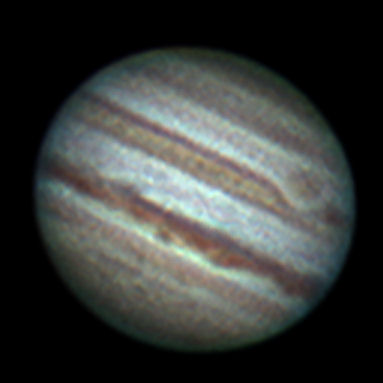
Wesley impact scar
Posted in Astrophotography with tags 150/750, afocal, Astronomy, Canon EOS 450D, GRS, Jupiter, Newtonian, no tracking, Photoshop, Rebel XTi, scar, shift-and-add, Wesley impact on 2009/08/16 by computerphysicslabSeveral days ago a comet hit Jupiter leaving a dark spot near one of its polar regions. Today this spot is still visible with a powerful telescope. Maybe if I have a high power Barlow lens I could have observed it visually. But fortunately there exist astrophotography, a technique that lets you observer indirectly what you can’t spot directly through a telescope.
In this same picture I include a Jupiter from the day before yesterday. The lack of atmospheric turbulence gave me a chance to get closer to the maximum theoretical resolution of a 6-inch telescope.

Jupiter selection & post-processing
Posted in Astrophotography with tags afocal, Astronomy, Canon EOS 450D, Jupiter, Newtonian, no tracking, post-processing, shift-and-add, Telescope on 2009/08/12 by computerphysicslabYesterday I took several videos with Canon EOS 450d (Rebel XTi) to Jupiter through the no-EQ mounted 150mm reflector. The final effective resolution of every video is slightly different, depending on the weather conditions and the focus reached in this precise instant. So I have chosen the two best sequential videos and appended each other into one final with double frame size.
After selecting and appending, I used Photoshop to apply a hard sharpen, and several other filters getting different final results. Here they are.

Jupiter & 3 moons
Posted in Astrophotography with tags 150/750, afocal, Canon EOS 450D, Jupiter, Newtonian, no tracking, Registax, shift-and-add, Telescope on 2009/08/12 by computerphysicslabJust some minutes ago.
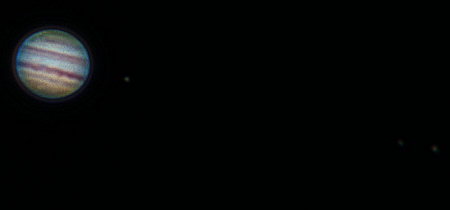
Hommel crater
Posted in Astrophotography with tags 150/750, afocal, Asclepi, Casio Exilim EX-FS10, crater, digicam, Hommel, Moon, Nearch, Newtonian, no tracking, Paint Shop Pro, Photoshop, Pitiscus, point-and-shoot, shift-and-add, Telescope on 2009/08/10 by computerphysicslabHommel is a big crater with nice craterlets inside, a Clavius-style set, but smaller, measuring 76 miles (129 Km). It is located in the South-East area of the visible Moon face. This area is pledge of small craters. It is similar in appearance to the sand of a beach. Pitiscus, Nearch and Asclepi are some of its neighbors.
The picture was taken at 19 days of lunation, that is 4 days after full Moon. This is the best timing to get sharp images of the crater’s walls’ shadows. The image is an integration of 27 subframes, each one taken at 9 Megapixels single shots with point-and-shoot digicam Casio Exilim EX-FS10.

Registax & post-processing
Posted in Astrophotography with tags Jupiter, post-processing on 2009/08/09 by computerphysicslabComputer assisted planetary and lunar imagery has reached the backyard amateur astronomer. With just a computer, a bunch of free software from Internet and a telescope (or even binoculars) and a point & shoot digital camera you will own the basic setup to do interesting astrophography jobs, mainly in the solar system realm.
The information obtained from a sensor device is pretty blurry, lacking of contrast and noisy as hell when shooting through a telescope or some other instrument with magnification. Atmosphere also conspire against us, because actually it is not as invisible as we thought at first. Windy nights or thermal issues may spoil our footage. That’s way disappointing. But there is a big pro when computer assisted image restoration shows up.
Here it is an example. Jupiter as recorded with a 6-inch telescope. Second step is the result of applying Registax 5 to the sequence. And step 3 is the final touch of sharp, color and contrast enhancement in Photoshop or any other similar software.
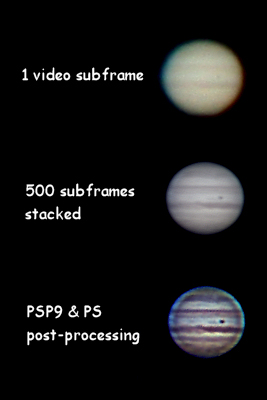
Mare Crisium & Tranquillitatis
Posted in Astrophotography with tags 150/750, afocal, Astronomy, Canon EOS 450D, Lu, Mare Crisium, Mare Tranquillitatis, Moon, Newtonian, no tracking, Paint Shop Pro, Proclus, Rebel XTi, Reflex, Registax, shift-and-add, Telescope on 2009/08/08 by computerphysicslabTwo days after full moon Mare Crisium shows a nice landscape of mountains and shadows. Some of its inner crates are visible in this picture. The small crater Swift is on the limit of visibility. The big impact called Proclus and its rays are remarkable.
To take this image I used the Canon EOS 450d, Rebel XTI DSLR camera recording video subframes and later I stacked them up with Registax 5. Some small tweaks on Paint Shop Pro 9 and ready.
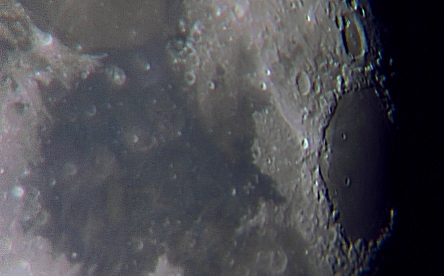
Full Moon
Posted in Astrophotography with tags 150/750, Astronomy, Canon EOS 450D, Canon EOS Rebel XTi, Full Moon, Newtonian, no tracking, Reflex, Registax, saturation, shift-and-add, Telescope on 2009/08/06 by computerphysicslabIn order to catch the Moon, I took 4 single shots at prime focus through my 150/600 telescope. As I lack of a T-mount adapter I had to take them in handheld mode. After de-rotating them accordingly, I stacked them up with Registax 5 and removed the noise a little bit. I used the body camera Canon EOS 450d (Rebel XTi) at high resolution, low sensitivity (ISO 100) and high shutter speed 1/2000. This is the result after a blow up in saturation:

Io’s shadow over Jupiter
Posted in Astrophotography with tags 150/750, afocal, Astronomy, Canon EOS 450D, Io, Jupiter, no tracking, Paint Shop Pro, Registax, shift-and-add, Telescope on 2009/08/05 by computerphysicslabAs Io passes in front of Jupiter, a big shadow is cast over the planet. In this picture I took tonight, it is clearly visible the dark point of shadow in the dead center of Jupiter. At its right a small spot that you may barely watch is Io.

In order to get a sharp image I used a Van Citter deconvolution process.
Jupiter occultation of 45 Cap
Posted in Astrophotography with tags 150/750, 45 Cap, afocal, Astronomy, Bright star, Casio Exilim EX-FS10, Jupiter, Newtonian, no tracking, occultation, Registax, shift-and-add, Telescope on 2009/08/04 by computerphysicslabJupiter occultation of 45 Cap tonight:
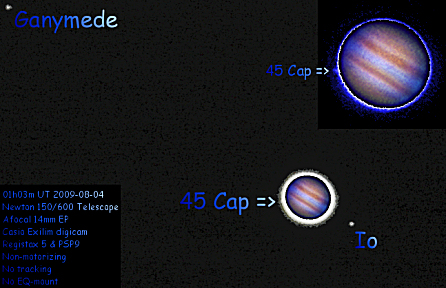
Jupiter with Exilim, 450d & Webcam
Posted in Astrophotography with tags 14mm, 150/750, afocal, Astronomy, Canon EOS 450D, Casio Exilim EX-FS10, Eyepiece, GRS, Jupiter, Newtonian, no tracking, Philips, Rebel XTi, Registax, shift-and-add, Telescope, ToUcam Pro, webcam on 2009/08/03 by computerphysicslabHere I have integrated my best images of Jupiter taken with 3 different cameras:
* Casio Exilim EX-FS10
* Canon EOS 450D (Rebel XTi)
* Webcam Philips ToUcam Pro
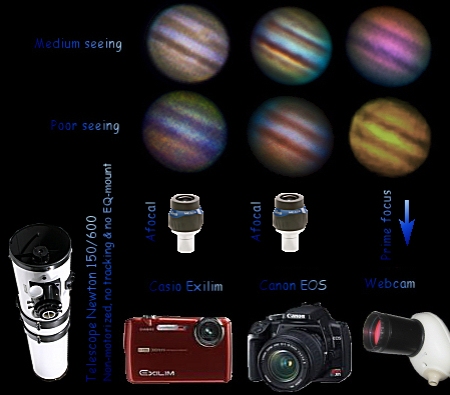
Voyager I vs. Newton 150/600
Posted in Astrophotography with tags 150/750, Astronomy, Jupiter, Newtonian, Telescope, Voyager I on 2009/07/30 by computerphysicslabTrying to find out which are the best colors and contrast to apply to a Jupiter I have come out with this comparative picture, between what Voyager I spacecraft could see and what I could spot last night with my humble newtonian telescope.

Jupiter post-processing
Posted in Astrophotography with tags afocal, Astronomy, Casio Exilim EX-FS10, good seeing, Great Red Spot, GRS, Jupiter, Newtonian, no tracking, Paint Shop Pro, Registax, shift-and-add, Telescope on 2009/07/29 by computerphysicslabI have been lucky tonight. Good seeing to see Jupiter. Using a small binoculars between the eyepiece and my eye I could spot visually Jupiter in high definition at an effective 450x magnification. That’s pretty good for a 150/600 reflector, isn’t it?
As you may appreciate in the following picture, the GRS (Great Red Spot) is clearly visible near the center of the planet. Several details are visible in the Jupiter’s bands. The image was obtained with a non-tracking Newtonian 6-inch telescope, a 14mm eyepiece, a Casio Exilim EX-FS10 digital camera that recorded 165 subframes. Registax 5 dealt with the alignment and stacking process. Dyadic Wavelets were applied to get contrast and details. PSP9 did the post-processing. The footage was taken exactly at 2009-07-28 03:33 UT.
Here several post-processing results are shown. The first one is that I like more.
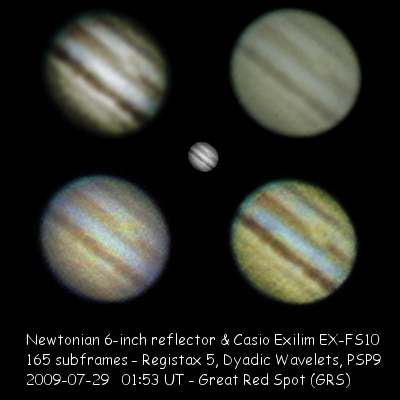
Jupiter, Europa & Ganymede
Posted in Astrophotography with tags afocal, Astronomy, Casio Exilim EX-FS10, Europa, Ganymede, Jupiter, no tracking, shift-and-add, Telescope on 2009/07/28 by computerphysicslabHere it is, Jupiter, Europa & Ganymede.

My best Jupiter so far
Posted in Astrophotography with tags 6 inches, Astronomy, Jupiter, Newtonian, no tracking, Philips Toucam Pro, Reflector, shift-and-add, Telescope, wavelets, webcam on 2009/07/26 by computerphysicslabMy 6-inch reflector working over a photographic tripod, and a webcam recording the focal plane. This is the resulting image, once overprocessed, yes, I give you that.
With Registax 5 I stacked 150 subframes and then applied dyadic wavelets. Some retouching with Paint Shop Pro 9 and fractal zooming under Photoshop.
The footage corresponds to 2009-07-26 at 01:44 UT.
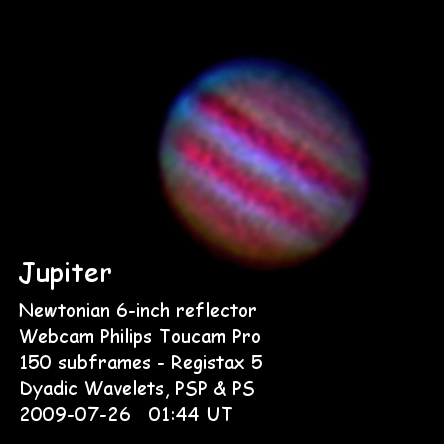
Lyra & Hercules constellations
Posted in Astrophotography with tags Canon EOS 450D, Constellations, DSLR, Hercules, Lyra, M13, M92, Nebulosity 2, Paint Shop Pro, Photoshop, shift-and-add, Stellarium, suburban sky on 2009/07/23 by computerphysicslabLast night Lyra and Hercules were located near the zenith of my suburban sky, so I could make a series of 90 shots with 10 seconds of exposure each one. My equipment was the DSLR camera Canon EOS 450 (Rebel XTi). This image sequence is equivalent to a 15 minutes long single shot. After adding them with the shift-and-add technique, and substracting a dark frame (via Photoshop) that includes light pollution I got a final picture. I have aligned (using Nebulosity 2 software) the Stellarium map of the area and created an animated gif that switchs from the photo to the map continuously. It seems every star is located correctly where it should be 😉
Globular clusters M13 and M92 are there in the photo like 2 stars.
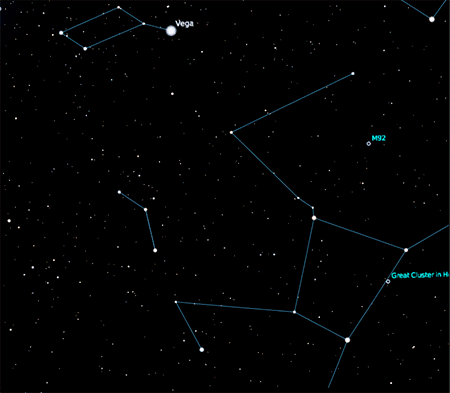
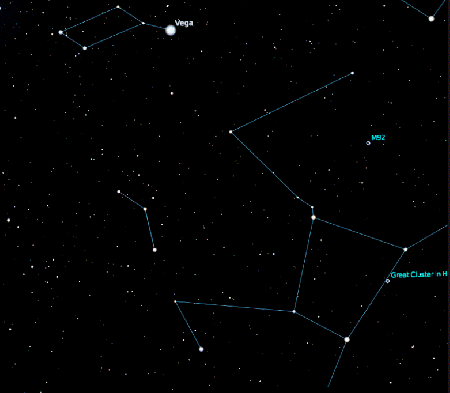
Jupiter’s galilean moons
Posted in Astrophotography with tags afocal, Callisto, Casio Exilim EX-FS10, Europa, Galilean moons, Ganymede, Io, Jupiter, no tracking, Registax, satellites, shift-and-add on 2009/07/22 by computerphysicslabGalilean moons are very easy to observe using some kind of instrument to get some magnification. With just a binoculars would be enough to spot the four moons of Jupiter. They are constantly rotating around Jupiter. Every day their relative distances and positions changes. Their names are Io, Callisto, Europa & Ganymede. They all have a similar size and brightness. When passing in front of the big planet, they cast a shadow over the gaseous surface of Jupiter. It is required a telescope to observe such events.
Here it is a picture I took tonight with a digital pocket camera through a 14mm eyepiece and a 150 mm newtonian reflector telescope with no-tracking system.
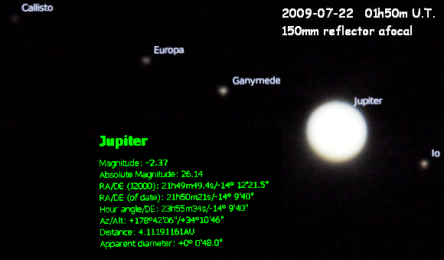
Light Pollution
Posted in Astrophotography with tags batch processor, Canon EOS 450D, dark frame, Deep sky, DeepSkyStacker, DSLR, image arithmetic, light pollution, no tracking, Paint Shop Pro 9, shift-and-add on 2009/07/21 by computerphysicslabLight pollution in suburban skies makes nearly impossible astrophotography. Nevertheless, there exists some computer techniques to make it possible. I have used a dark frame to catch the exact pattern of the light pollution in the photographed area. The way to accomplish this is not difficult. Shooting in continuous mode the DSLR camera facing the zenith in my home window, and forcing every frame to last 15 seconds I got a sequence of subframes to be processed afterward.
To get the dark frame I do some image arithmetic with Paint Shop Pro 9: I choose 3 or 4 distant subframes and compute them using “darkest” option. This way, stars become to fade until disappearing.
With Paint Shop Pro 9 and batch processor I apply a barrel lens distortion of 17 (empirical value to correct a 18mm focal lens like Canon’s) to every subframe and also to the dark frame.
Once got the dark frame DeepSkyStacker is needed to stack the single subframes and substract the dark frame. The sideral drift of the field is automatically compensated with the intelligent algorithm that DeepSkyStacker provides.
The resulting image is surprising taking into account this is an urban sky.

From a light polluted city
Posted in Astrophotography with tags Aquila, Canon EOS 450D, light pollution, Lyra, Milky Way, Nebulosity 2, no tracking, urban sky, widefield on 2009/07/19 by computerphysicslabThis image was taken in the center of a light polluted city with almost 1 million inhabitants. Using a dark frame of the polluted sky I could catch the Milky Way. Obviously it was impossible to observe it with naked eye.
The image is the result of adding 20 subframes of 15 seconds of exposure each one at ISO 1600. After applying a barrel distortion filter to compensate lens distortion the images become integrable. Using Nebulosity 2 software I could compensate the sideral motion of the sky.
The quality of the image is very low. The point here is not quality but the successful of avoiding light pollution in a widefield Milky Way shot. The area corresponds to the border of Lyra constellation towards Aquila constellation.

Bullialdus area
Posted in Astrophotography with tags afocal, Bullialdus, Casio Exilim EX-Z80, Meade Lightbridge 16", Moon, no tracking, Pitatus, Promontorium Taenarium, Rükl plate 53 & 54, Registax, Rupes Recta on 2009/07/18 by computerphysicslabA lot of features are located in this area of the Moon. Some of them are: Rupes Recta, Pitatus, Promontorium Taenarium, Bullialdus. It corresponds to the area covered by the Rükl plates 53 & 54.
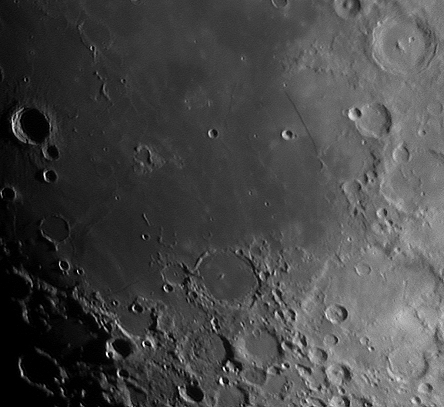
Bullialdus is the big crater at upper left side, in the shadows. Pitatus is centered in the lower side. Inside several details are visible: a peak and an inner rim. Rupus Recta is the large straight wall on the right side.
This picture was obtained after stacking (with Registax 5) 20 single frames taken with Casio Exilim pocket digital camera in afocal projection through an eyepiece using a Meade Lightbridge 16-inch dobsonian telescope.
Mare Crisium
Posted in Astrophotography with tags afocal, Casio Exilim EX-Z80, crater, Eimmart, Mare Anguis, Mare Crisium, Meade Lightbridge 16", Moon, Peirce, Picard, Registax, the serpent sea on 2009/07/03 by computerphysicslabMare Crisium is a big and round dark spot in the face of the Moon. It is easily visible through the naked eye on the right side (East) of the Moon. Inside Mare Crisium there are some interesting features, like small craters as Picard or Peirce. Proclus is the bright crater on the left (West) beyond the Crisium border. Some bright rays emerge from it crossing part of Mare Crisium. At north-east of Crisium (above right) there is a small and dark surface called Mare Anguis (the “serpent sea”). A big crater is visible at its left (West) known as crater Eimmart.
This picture was taken as the integration of 30 subframes stacked in Registax 5, from a video made with Casio Exilim EX-Z80 afocal on Meade Lightbridge 16-inches big Dobsonian, with no tracking.

Canon EF-S 18-55mm barrel distortion
Posted in Astrophotography with tags Canon EF-S 18-55mm, field curvature, lens, no tracking, shift-and-add on 2009/05/19 by computerphysicslabIn order to stack non-tracking subframes for widefield astrophotography, it is important to get images with no field curvature. My lens Canon EF-S 18-55mm when working at lowest zoom, that is 18mm of focal, presents a clear barrel distortion as reported in the image below. Nevertheless, it can be corrected applying a pincushion lens distortion of 15 in Paint Shop Pro. But the image border remains distorted so it is needed a crop reducing the image to an 80% of its original size.
Of course, the best solution is to stop using the 18 mm focal length for shift-and-add astrophotography. Instead longer focal is advisable like 35 mm, where the lens does not show any significant distortion in the field of view.
Another advice to get a sharp focus and pinpoint stars with Canon EF-S 18-55mm lens is to always use a focal ratio no less than F:5 and no more than F:10. Under F:5 the lens coma aberration would mess the stars near the image border and over F:10 the diffraction would create big Airy patterns instead of pinpoint stars.

I have said above that “it is important to get images with no field curvature to do shift-and-add astrophotography”. I must correct it. Sky pictures are not like an image of a wall. A wall is a plane surface, but the sky is not. Actually, the sky is an sphere, the celestial sphere, that is constantly rotating around Polaris. So, the correct way to add images is not converting them to plane field, but to spherical field in the right proportion.
I have told you that pincushion lens distortion corrects the field. That is truth, but it is not appropriated to process non-tracking subframes. The subframes must firstly be corrected to show an spherical field. So the right filter to apply is indeed a barrel lens distortion, increasing this way the natural barrel that comes with the lens.
It is easy to verify this, just trying to overlap 2 distant subframes. The first and the last of the session may be optimal. Only after applying a barrel of 17 in Paint Shop Pro I could overlap successfully the subframes, preserving angles and distances between stars.
DSLR to a LightBridge
Posted in Astrophotography with tags Canon EOS 450D, Canon EOS Rebel XTi, Meade Lightbridge 16", prime focus, Reflex, Telescope on 2009/05/18 by computerphysicslabSomeone asked: “Has anyone had difficulty focusing a DSLR to a LightBridge? I bought the appropriate adapters but cannot focus on any subject. It would seem that the LightBridge focuser extends too far away from the secondary. It seems the obvious answer is to install a focuser with less length. ”
Yesterday I was also trying to focus my DSLR Canon EOS Rebel XTi (EOS 450d) through my Meade Lightbridge 16″, but it was not possible. I haven’t still bought any T-adapter, because I was not sure it could reach the focus. Indeed it doesn’t reach it even without any adapter.
Maybe changing the focuser to a zero profile one could work. Or maybe not.
There is a trick to find out where the focal plane is exactly. When seeing the Moon, remove any eyepiece from the focuser and project the light into a cardboard perpendicular to the focuser axis. When the Moon gets clear and focused, there it is exactly located the focal plane at prime focus.
Knowing the distance from the CCD camera to the T-adapter it is possible to find out if a low profile focuser could reach the focus for prime focus astrophotography.
A bit better Saturn
Posted in Astrophotography with tags afocal, Casio Exilim EX-FS10, Dione, Meade Lightbridge 16", no tracking, Registax, Rhea, satellite, Saturn, Telescope, Titan on 2009/05/16 by computerphysicslabFortunately, yesterday was not cloudy and I could do further experiments with Saturn. Using a Barlow 2x and Casio Exilim EX-FS10 camera I filmed some videos at highest resolution through the big dobsonian telescope Meade Lightbridge 16-inch. Weather conditions were good. I did a better collimation than previous days, getting sharp focus from time to time. Stacking the frames with Registax 5 I got this resulting image:

In the left side of the image, it is visible a satellite of Saturn. It is Titan, with 9 magnitude. Over it, a bit at right there is almost visible another one, Rhea of magnitude 10. Visually it was observable another one aligned to Titan and Rhea, but it is not visible in the image. It was Dione with 11 magnitude.
Luckily this image shows the gap between foreside ring and its rear part. The image effective resolution according to my calculations is 1 arcsecond. Two cloud bands are visible one in the north hemisphere and the other in the south.
I would like to break the 1 arcsecond resolution barrier, but I don’t know if it is possible with this telescope. Theoretically it delivers a 0.3 arcsecond resolution because it has 400mm of mirror diameter.
Dobsonian Astrophotography
Posted in Astrophotography with tags Deep sky, Dob, Dobsonian, Moon, planets on 2009/05/14 by computerphysicslabQuestion: I have a 14 inch dob and interested in taking photos with it. Do I really need tracking?
I have a Dobsonian Meade Lightbridge 16-inch and I am also trying to do astrophotography with it. This is a challenge. The Moon is the easiest target for a Dob. Tracking is not compulsory to take good images of the Moon. Next target may be planets. Here it is my last image of Saturn through my Dob:
Next target would be bright stars and clusters. And the most difficult target of all is deep-sky astrophotography. With no tracking system you have to use some tricks to get deep sky images. I am using shift-and-add technique with moderate results.
My focuser does not let me to use my DSLR camera at prime focus, so I am using afocal method through low power eyepieces. You don’t have to spend much money to do this kind of photographic experiments. Patience and effort sometimes give more satisfaction that a lot of money expended in sophisticated equipment.
Tamron SP 54B 300mm F:5.6
Posted in Astrophotography with tags Adaptall 2, adapter, Canon Digital Rebel XSi, Canon EOS 450D, Telephoto on 2009/05/08 by computerphysicslabI am trying to engage an old telephoto 300mm Tamron SP lens into my Canon EOS 450d (Canon Digital Rebel XSi), but I haven’t been able to find any adapter in the market. The exact model of my lens is “Tamron SP 54B 300mm F:5.6”. Respecting the mount, I have an ancient adapter for my old analog reflex Praktica. The lens has a bayonet mount, and the adapter translates it into a screw-threaded mount. In both bayonet and screw mounts there is a brand name: “Adaptall 2”.
Someone has told me to buy a “M42 to EOS adapter”, but I am not sure if engaging two adapters in serial, would let me focus infinity afterward.
So, I am looking for an adapter that let me match correctly this telephoto lens to my Canon EOS 450d. Here is a picture showing the mount and the old adapter. Any hint would help me for sure.
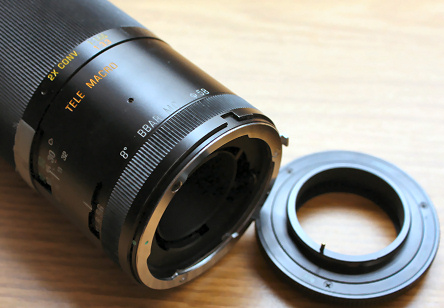
Crescent Moon focal 55mm
Posted in Astrophotography with tags Canon EOS 450D, Moon on 2009/05/07 by computerphysicslabThis is a picture of the crescent Moon taken with the DSLR camera Canon EOS 450d and their most standard lens kit: EF-S-18-55mm.
Zoom at maximum, that is 55 mm of focal length. No tracking, only static tripod to avoid blur.
I hope you like it …

Aristarchus crater
Posted in Astrophotography with tags afocal, Aristarchus, Casio Exilim EX-FS10, crater, Full Moon, Telescope on 2009/05/06 by computerphysicslabAristarchus is a rather peculiar crater. It is for me the most exciting pattern in the Moon. It is located over a weird squared area and there is an important valley near it, to its north-west. It is visible since now, 2 days before Full Moon.
The picture was shot tonight through a non-motorized 150mm (6 inches) reflector using high definition video capture with Casio Exilim EX-FS10.
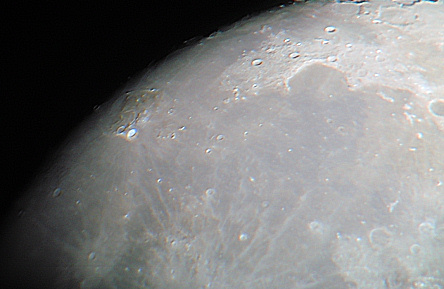
Internet free astrogallery
Posted in Astrophotography with tags Astrogallery, Astronomy, AweSky, Pictures, wiki on 2009/05/06 by computerphysicslabWe have developed an Internet free astrogallery. We spent time looking for free astrophotography galleries in Internet, working as a wiki project. We found Moon galleries like LPOD and several brand related galleries, but not one specially dedicated to the night sky. So we decided to build one that could host the images of amateur atronomers categorized by subject and ordered by votes and visits.
The gallery is online since last week and we are doing efforts in promoting it and populating the photographic slots available. We would like your organization to make some reference to our project, not only to get new visits, but also to get the people interested known about this project.
Check it out at http://www.awesky.com/
Thanks in advance.
Meade Lightbridge smoothness
Posted in Astrophotography with tags Dobsonian, Meade Lightbridge 16", Newtonian, no tracking, Reflector, Telescope on 2009/05/05 by computerphysicslabHi CPL,
Thanks for posting that cool vid of the 16″ Lightbridge. I just spoke with someone at a telescope store who said they were looking to get rid of their 12″ Lightbridge because they said it is very shaky when viewing, and gives an unstable image.
I just was in a shop which had an 8″ Lightbridge and I would describe it as very smooth and rock solid.
Can I ask you if you’ve had any shaky or bouncing issues with your 16″?
I’m thinking of the 12″ for myself!
Thanks, PK
—————————————————————————————-
Meade Lighbridge does not come with slow motions for altazimuth movements. If you compare the movement of the Lightbridge with that of a tripod mounted refractor, for example, probably the tripod mounted is going to be much precise.
Nevertheless, it depends too much on what kind of observation are you planning. Watching the Moon, Lightbridge may became very smooth and exact in movement, because you always have a bright lunar surface all over the field of view and the movement you apply to the optical tube is constantly compared to the drift as seen through the eyepiece. On extensive deep sky objects, the same happens. The most difficult objects to track are planets, because the surrounding field of view is pitchblack and you lose any references once the planet gets out of the field.
If you try to use high power eyepieces with small apparent field of view with a planet, the lack of equatorial mount and a sideral motor drive may become a nightmare. In this cases, my advice is to always use widefield eyepieces and reduce the magnification if necessary.
To get a smooth movement it is important to balance correctly the optical tube, adding some magnets at the bottom side of the tube, near the mirror. Do not forget to check that the base of the dobsonian mount is not tilted. Following these advices, the telescope will have a very smooth movement in both axis, as shown in my video at http://www.youtube.com/watch?v=WWUGCk0wN24
The tracking becomes more difficult as longer the focal length. So Meade Lightbridge 16″ is the most difficult to track, because a slight movement in your hands transforms in a great movement in the field. Lower aperture telescopes, have less focal distance and apparent movements in the field are smoother.
If you are planning the use of the telescope for observational purposes, you won’t have any problems with the smoothness of the tracking once you get trained in several sessions. If you plan to do astrophotography, dobsonian movement may become a problem. Nevertheless, I do astrophotography of Moon, planets, and stars through my Meade Lightbridge 16″. You may check it out at my webpage: https://computerphysicslab.wordpress.com/
My final advice is: if you have previously be using regularly a smaller scope doing astronomy, you won’t find any problem using any of Meade Lightbridge series. Collimation is an important point to deal with in this scopes, but the quality of its elements is superb, and the price is really good.
Proclus and surroundings
Posted in Astrophotography with tags afocal, Casio Exilim EX-Z80, Mare Crisium, Mare Tranquillitatis, Meade Lightbridge 16", no tracking, Proclus, Registax, shift-and-add on 2009/05/02 by computerphysicslabStacked from a video under Registax 5 and stitched with Autostitch, I got yesterday this Moon mosaic. Equipment: Meade Lightbridge 16″ and Casio Exilim EX-FS10.
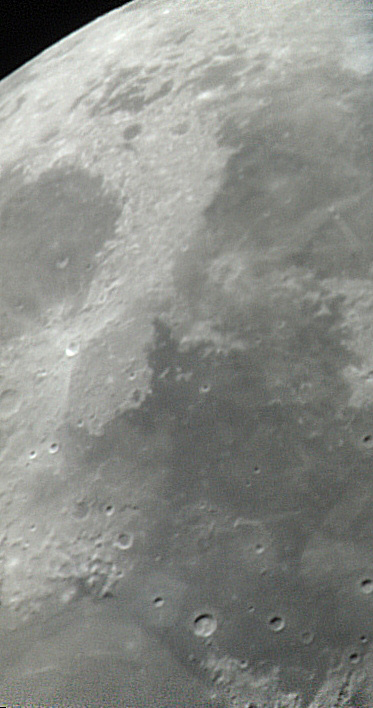
4.6 days lunation Moon
Posted in Astrophotography with tags 9Mpx, afocal, Astronomy, Binocular, Casio Exilim EX-FS10, Mare Nectaris, Mare Tranquillitatis, Moon, Registax, shift-and-add, terminator, Vixen 12x80 on 2009/04/29 by computerphysicslabTonight the Moon is crescent, and high in altitude. It is a good opportunity to record our natural satellite. Terminator is almost reaching Mare Serenitatis. Mare Nectaris (actually a gulf of Mare Tranquillitatis) is now fully illuminated and its Western border walls are clearly visible.
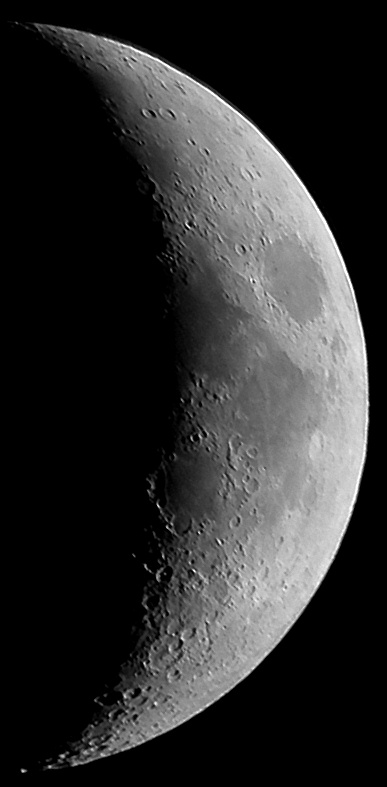
Tonight’s Moon
Posted in Astrophotography with tags 9Mpx, afocal, Binocular, Casio Exilim EX-FS10, Moon, Registax, shift-and-add, Vixen 12x80 on 2009/04/28 by computerphysicslabHere we have a 3.5 days lunation Moon. Mare Crisium is completely illuminated and some fine details may be seen, like small Swift crater (5 kms diameter). The image was a sum (Registax 5) of 10 subframes at 9Mpx using the Casio Exilim EX-FS10 and Vixen 12×80 binocular.
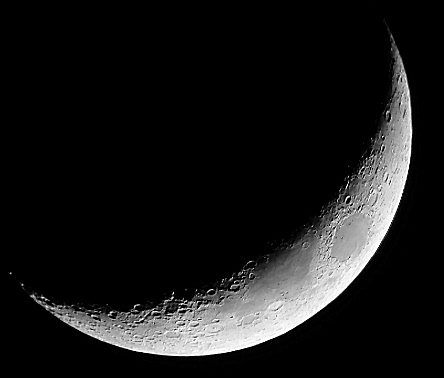
Orion in Spring
Posted in Astrophotography with tags 18-55mm lens, Canon EOS 450D, constellation, dusk, Orion, Paint Shop Pro, pine branch, Spring, subframe on 2009/04/28 by computerphysicslabOrion constellation may be difficult to sight in Spring due to its low altitude near the bright west horizon at dusk. Nevertheless I took one subframe of 8 seconds of exposition under ISO-400 applying my new Canon EOS 450d plus 18-55mm lens.
With Paint Shop Pro I subtracted the background gradient due to dusk light. There is visible a pine branch below.
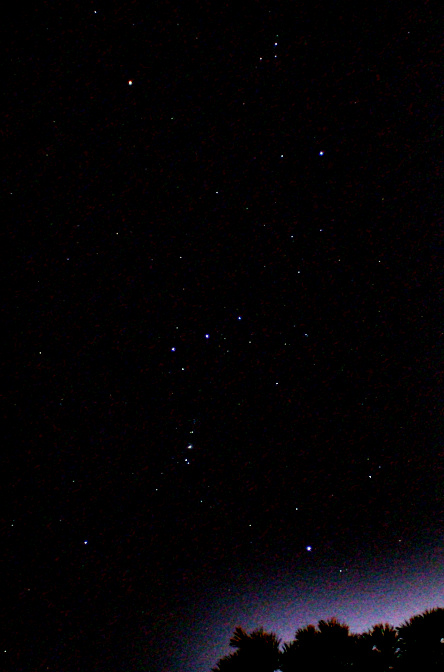
Beehive cluster Wide Field
Posted in Astrophotography with tags Canon EOS 450D, M44, Open Cluster, Praesepe, shift-and-add on 2009/04/14 by computerphysicslabI have recently bought a DSRL camera: Canon EOS 450D. Today it has shot for the first time to the stars. Beehive cluster was an easy target tonight. The maximum zoom the lens permits let us separate some of the components of the M44 cluster. The resulting image has been made of ten shots of 5 seconds of exposition each one.

Waxing Gibbous Moon
Posted in Astrophotography with tags afocal, Binocular, Casio Exilim EX-Z80, Gibbous, Moon, Nebulosity 2, no tracking, Paint Shop Pro, phase, Registax, shift-and-add, Vixen 12x80 on 2009/04/08 by computerphysicslabYesterday’s Moon in phase waxing gibbous as seen through the Vixen 12×80 binocular, here it is. Registax 5 stacked 55 individual frames of 8 Mpx each. Nebulosity 2 was used to compensate the sideral movement and perform the de-rotation. Sharpening with Paint Shop Pro.
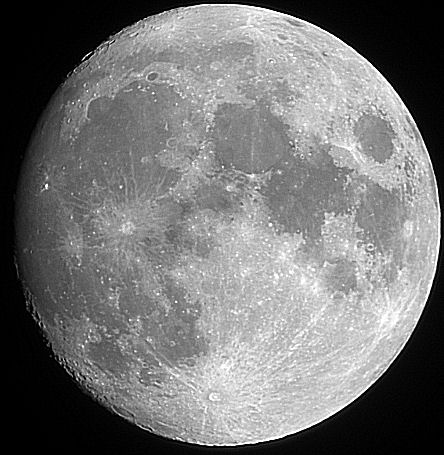
Copernicus Crater
Posted in Astrophotography with tags afocal, AutoStitch, Casio Exilim EX-Z80, lunation, Meade Lightbridge 16", Moon, no tracking, Registax, terminator on 2009/04/04 by computerphysicslabCopernicus is the name of a big Lunar crater. A video taken with the compact digital camera and the Meade Dobsonian was processed using Registax, and the resulting three frames were stitched with AutoStitch. We see here a zone in the terminator for a 9 lunation days Moon around Copernicus:
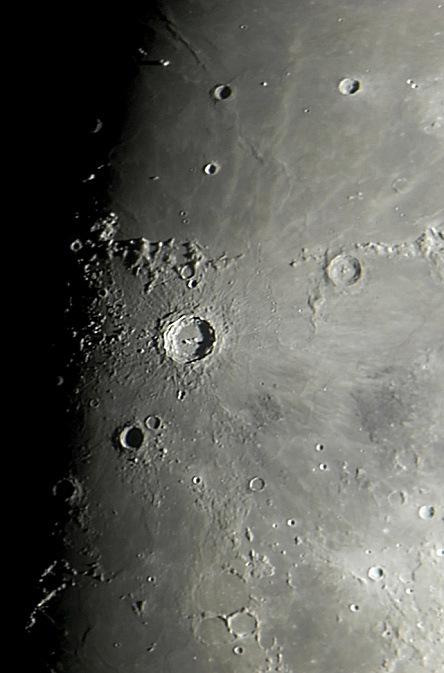
LPOD Gallery & Crescent Moon
Posted in Astrophotography with tags gallery, LPOD, profile on 2009/04/04 by computerphysicslabLPOD gallery has published my Crescent Moon photography. Here is the link: LPOD Gallery.
I signed up and uploaded the photography two days ago. The approval has been fast. I had to fill a profile form as shown here: Profile.
Tycho and the South Pole
Posted in Astrophotography with tags afocal, Casio Exilim EX-Z80, Clavius, Dob, Meade Lightbridge 16", Moon, non-motorized, Paint Shop Pro, Registax, shift-and-add, South Pole, Telescope, terminator, Tycho on 2009/04/04 by computerphysicslabA sequence of shots to the Moon taken with the Dob Meade Lightbridge 16″ telescope has been integrated into one final image, thanks again to Registax and Paint Shop Pro. This mosaic of Tycho crater and the South Pole region is composed of 30 individual frames. The biggest crater in the terminator is Clavius. Inside it there a lot of small craters.
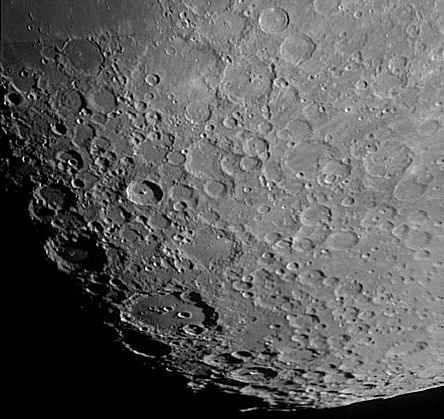
Silberschlag casts two shadows
Posted in Astrophotography with tags afocal, Astronomy, Binocular, Casio Exilim EX-Z80, Mare Tranquillitatis, Moon, shift-and-add, terminator, Vixen 12x80 on 2009/04/03 by computerphysicslabSilberschlag is a small Moon crater near Mare Tranquillitatis. What is my surprise when I observe that this crater shadow is proper of two peaks instead of a crater rim. Watch the picture and think about it. Is that normal?
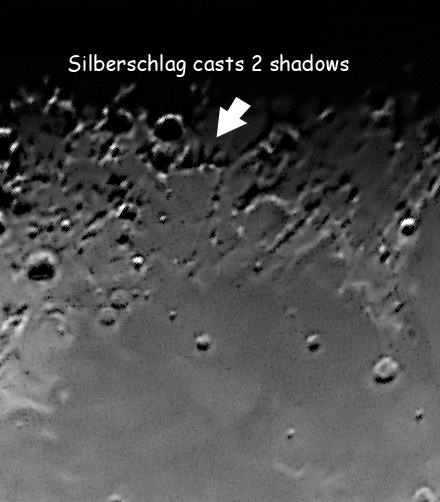
55 frames stacked in Registax
Posted in Astrophotography with tags afocal, Binocular, Casio Exilim EX-Z80, Moon, Registax, Vixen 12x80 on 2009/04/02 by computerphysicslabAfter stacking 55 frames of yesterday’s Crescent Moon, forcing a bit the saturation, and sharpening using the finest wavelet available, I am proud to introduce this Moon picture:
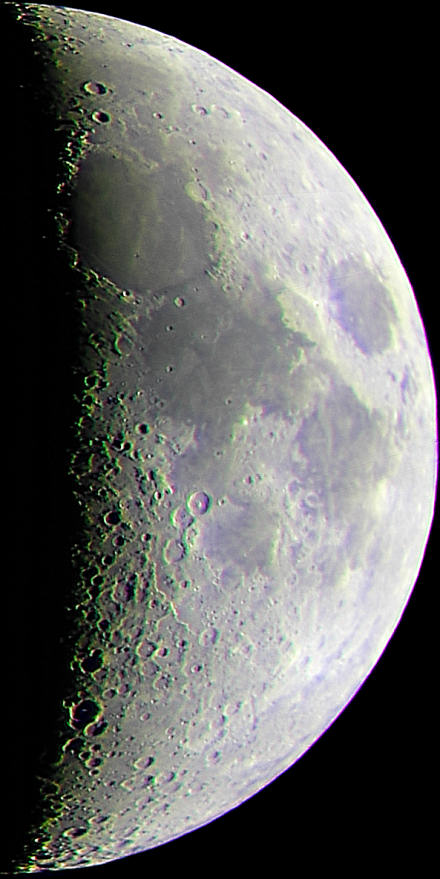
Foggy Crescent Moon
Posted in Astrophotography with tags afocal, Binocular, Casio Exilim EX-Z80, Crescent, Moon, Vixen 12x80 on 2009/03/31 by computerphysicslabYesterday’s moon was a bit foggy in my location. Nevertheless I got an image that I am very proud of, because it is the first time I obtain a nearly perfect focus thanks to the binocular focus tip. When doing afocal exposures, you may get a sharp focus using another binocular over the lens. This way you guarantee an infinite precise focus for the camera.
This image was taken as usual, through Vixen 12×80 binoculars and with the Casio Exilim EX-Z80 pocket digital camera. I used only green channel data, because it was the sharpest.

Looking for Sirius B
Posted in Astrophotography with tags Bright star, Casio Exilim EX-Z80, Meade Lightbridge 16", shift-and-add, Sirius on 2009/03/31 by computerphysicslabSirius is a difficult binary system, hard to resolve. I am trying it, and I have got one image that shows a dim star very near to Sirius A, but I think it isn’t Sirius B. I have been trying to find out which is the name of the star. I still don’t know it. Searching in Internet (and star atlas) other images of the area I see the star exists, but with no name so far. Here are the sources found:
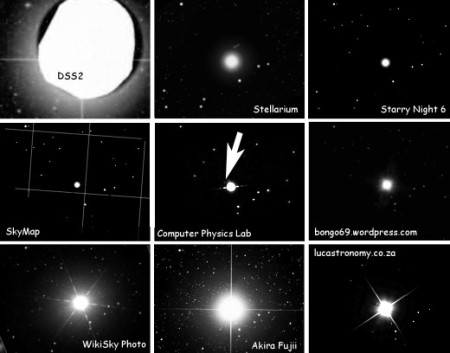
Mizar & Alcor
Posted in Astrophotography with tags afocal, Alcor, Big Dipper, Casio Exilim EX-Z80, dobsonian reflector, double star, Meade Lightbridge 16", Mizar, no tracking, shift-and-add, Sidus Ludoviciana, Ursa Major on 2009/03/24 by computerphysicslabMizar and Alcor are probably the most well known double star in the sky. Located in Ursa Major,it is very easy to separate Mizar from Alcor, even with the unaided eye.
Sidus Ludoviciana is the faint star between Mizar and Alcor. Mizar is the brightest one, which in fact is a binary system: Mizar A & B, with an angular separation of 14 arcseconds.
Photo taken with the dobsonian reflector Meade Lightbridge 16″, using afocal eyepiece proyection. Here we see 222 shots of 0.5 seconds of exposure stacked. No tracking, shift-and-add method.
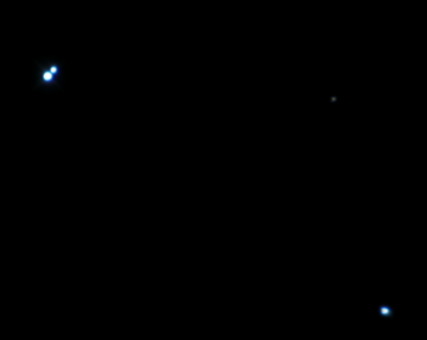
Where is Sirius B?
Posted in Astrophotography with tags afocal, Canis Major, Casio Exilim EX-Z80, Meade Lightbridge 16", shift-and-add, Sirius, Telescope on 2009/03/23 by computerphysicslabAfter resolving the binary system of Castor I tried unsuccessfully to spot Sirius B. Theoretically it is possible using the Meade Lightbridge 16″, but maybe another luckier night … Integrating 200 half second exposure frames I got this result:

Chertan in Leo Major
Posted in Astrophotography with tags Binocular, Casio Exilim EX-Z80, Chertan, galaxies, Leo Major, M65, M66, shift-and-add, Vixen 12x80 on 2009/03/23 by computerphysicslabChertan is an important star as a reference to locate several galaxies in the area, for example M65 and M66. Tonight I have stacked 550 shots into one image. The night has been clear, but I am located in a light polluted urban area. It has been necessary to substract the pollution from the background twice. The map shows stars up to 10th magnitude and the photo shows up to 12th magnitude.

Meteor in Canis Minor
Posted in Astrophotography with tags 3200 Phaethon, Binocular, Canis Minor, Casio Exilim EX-Z80, Geminids, Meteor, Procyon, shift-and-add, Vixen 12x80 on 2009/03/22 by computerphysicslabSerendipitously, I got captured this meteor while exposing Procyon in a shift-and-add series. The field of view measures around 3 degrees. The meteor track becomes cut, but it seems to be not much longer. This meteor could achieved magnitud 1 or 0, similar in bright to Procyon. Taking into account its directionality it may belong to Geminids meteor shower caused by the asteroid 3200 Phaethon.

M42 last night
Posted in Astrophotography with tags Binocular, Casio Exilim EX-Z80, Great Nebula of Orion, M42, Manaluna Observatory, Messier Marathon, no tracking, Orion, shift-and-add, Trapezium, Vixen 12x80 on 2009/03/21 by computerphysicslabLast night I could enjoy a really clear night sky at Manaluna Observatory. Meanwhile some of my partners were working hard to complete the Messier Marathon, I took 3 series of no-tracking shots through Vixen 12×80 binocular to M42 in Orion.
The truth is that what I could see through binoculars was much more brilliant and detailed than the next image by far. I think my Casio Exilim digital pocket camera is a bit insensible to dim light …
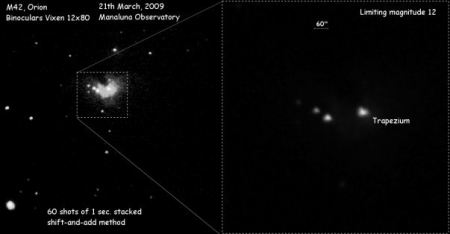
Trapezium is visible as a spot. The 20″ separation among its components is too close for my binoculars to resolve it. Remember that 20″ is the apparent diameter of Saturn.
Astrophotography Software
Posted in Astrophotography with tags Adobe Premiere, AstroArt, astrophotography software, DeepSkyStacker, EasyBMPtoAVI, Google Earth, Maximum entropy deconvolution, Neat Image, Nebulosity, onOne Genuine Fractals, Paint Shop Pro, PhotoAcute Studio, Photoshop, Registax, StarryNight, Stellarium, VirtualDub, WikiSky on 2009/03/20 by computerphysicslabIt is important to apply the best astronomical software to enhance your pictures. Otherwise noise, blur, light pollution, hot and cold pixels and low exposures can degrade our work. Here is a list of my favorite astrophotography software:
* Image Stacking: Registax, PhotoAcute Studio, Nebulosity and DeepSkyStacker.
* Retouching: Paint Shop Pro and Photoshop.
* Zooming: onOne Genuine Fractals.
* Sharpening: Maximum entropy deconvolution with AstroArt, and wavelets with Registax.
* Noise removal: Neat Image.
* Video edition: VirtualDub, Adobe Premiere and EasyBMPtoAVI.
* Night sky renderers: Stellarium, StarryNight, Google Earth & WikiSky.
Saturn and rings
Posted in Astrophotography with tags Binocular, edge-on, planet, Registax, rings, Saturn, Vixen 12x80 on 2009/03/18 by computerphysicslabSaturn is well placed these nights to be easily observed. The rings are edge-on, so they are difficult to capture with photography. Nevertheless I have got a series of shots and have stacked them all with Registax 5. Take into account I have used the Vixen 12×80 binocular to get this image. Imagine seeing Saturn rings edge-on with a magnification of only 12 …

Procyon, alfa Canis Minor
Posted in Astrophotography with tags alfa, Bright star, Canis Minor, Procyon on 2009/03/17 by computerphysicslabProcyon is a very bright star near Sirius. For testing purposes, I took a series of shots through my Vixen 12×80 binoculars. Using the shift-and-add method, also known as “image-stacking“, I could spot magnitude 10 stars near Procyon. I didn’t use any tracking, not even manual tracking.






